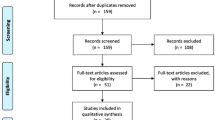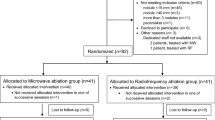Abstract
Background
This study was designed to evaluate the safety, efficiency, effectiveness, and overall long-term outcome in patients treated with microwave thermal ablation of hepatic tumors. Microwave ablation technology represents the next generation in ablative techniques for the treatment of hepatic malignancies. Currently there have been no large reports of its use in the United States with appropriate long-term follow-up.
Methods
An institutional review board-approved prospective phase II study of microwave ablation of hepatic malignancies from January 2004 to January 2009 was performed. All complications were recorded up to 90 days from operation and reported using an established five-point grading scale.
Results
One hundred patients underwent 270 ablations for hepatic malignancies. The most tumor types were as follows: metastatic colorectal cancer (50%), hepatocellular carcinoma (17%), metastatic carcinoid (11%), and other metastatic disease (22%). A majority of patents (53%) underwent combination hepatic resection and microwave ablation; 38% underwent ablation alone, 9% underwent ablation and additional organ resection, with 68% open procedures. Median tumor size was 3.0 (range, 0.6–6.0) cm, median number of tumors was 2 (range, 1–18), and median total ablation time was 13 (range, 5–45) min. Overall 90-day mortality was 0% and morbidity was 29%. One patient developed a hepatic abscess and no patients experienced bleeding complications. After a median follow-up of 36 months, 5 patients (5%) had incomplete ablation, 2 (2%) had local recurrence at the ablated site, and 37 (37%) developed intrahepatic recurrence at nonablated sites.
Conclusions
Microwave ablation of hepatic tumors is a safe and effective method for treating unresectable hepatic tumors, with a low rate of local recurrence.

Similar content being viewed by others
References
Seki S, Sakaguchi H, Kadoya H, et al. Laparoscopic microwave coagulation therapy for hepatocellular carcinoma. Endoscopy. 2000;32:591–7.
Ohmoto K, Miyake I, Tsuduki M, et al. Percutaneous microwave coagulation therapy for unresectable hepatocellular carcinoma. Hepatogastroenterology. 1999;46:2894–900.
Shibata T, Iimuro Y, Yamamoto Y, et al. Small hepatocellular carcinoma: comparison of radio-frequency ablation and percutaneous microwave coagulation therapy. Radiology. 2002;223:331–7.
Sato M, Watanabe Y, Ueda S, et al. Microwave coagulation therapy for hepatocellular carcinoma. Gastroenterology. 1996;110:1507–14.
Lu MD, Chen JW, Xie XY, et al. Hepatocellular carcinoma: US-guided percutaneous microwave coagulation therapy. Radiology. 2001;221:167–72.
Skinner MG, Iizuka MN, Kolios MC, et al. A theoretical comparison of energy sources–microwave, ultrasound and laser–for interstitial thermal therapy. Phys Med Biol. 1998;43:3535–47.
Wright AS, Sampson LA, Warner TF, et al. Radiofrequency versus microwave ablation in a hepatic porcine model. Radiology. 2005;236:132–9.
Wright AS, Lee FT Jr, Mahvi DM. Hepatic microwave ablation with multiple antennae results in synergistically larger zones of coagulation necrosis. Ann Surg Oncol. 2003;10:275–83.
Martin RC, Scoggins CR, McMasters KM. Microwave hepatic ablation: initial experience of safety and efficacy. J Surg Oncol. 2007;96:481–6.
Couinaud C. Le foie: Etudes anatomiques et Chirurgicales. Paris: Masson & Cie; 1957.
Vauthey JN, Choti MA, Helton WS. AHPBA/SSO/SSAT Consensus Conference on hepatic colorectal metastases: rationale and overview of the conference. January 25, 2006. Ann Surg Oncol. 2006;13:1259–60.
Martin RC, Jarnagin WR, Fong Y, et al. The use of fresh frozen plasma after major hepatic resection for colorectal metastasis: is there a standard for transfusion? J Am Coll Surg. 2003;196:402–9.
Martin RC, Edwards MJ, McMasters KM. Morbidity of adjuvant hepatic arterial infusion pump chemotherapy in the management of colorectal cancer metastatic to the liver. Am J Surg. 2004;188:714–21.
Reuter NP, Woodall CE, Scoggins CR, et al. Radiofrequency ablation vs. resection for hepatic colorectal metastasis: therapeutically equivalent? J Gastrointest Surg. 2008.
Lu MD, Xu HX, Xie XY, et al. Percutaneous microwave and radiofrequency ablation for hepatocellular carcinoma: a retrospective comparative study. J Gastroenterol. 2005;40:1054–60.
Siperstein A, Garland A, Engle K, et al. Local recurrence after laparoscopic radiofrequency thermal ablation of hepatic tumors. Ann Surg Oncol. 2000;7:106–13.
Goldberg SN, Charboneau JW, Dodd GD III, et al. Image-guided tumor ablation: proposal for standardization of terms and reporting criteria. Radiology. 2003;228:335–45.
Diederich CJ. Thermal ablation and high-temperature thermal therapy: overview of technology and clinical implementation. Int J Hyperthermia. 2005;21:745–53.
Iannitti DA, Martin RC, Simon CJ, et al. Hepatic tumor ablation with clustered microwave antennae: the U.S. Phase II Trial. HPB (Oxford). 2007;9:120–4.
Organ LW. Electrophysiologic principles of radiofrequency lesion making. Appl Neurophysiol. 1976;39:69–76.
Goldberg SN, Gazelle GS, Solbiati L, et al. Radiofrequency tissue ablation: increased lesion diameter with a perfusion electrode. Acad Radiol. 1996;3:636–44.
Abe T, Shinzawa H, Wakabayashi H, et al. Value of laparoscopic microwave coagulation therapy for hepatocellular carcinoma in relation to tumor size and location. Endoscopy. 2000;32:598–603.
Aramaki M, Kawano K, Ohno T, et al. Microwave coagulation therapy for unresectable hepatocellular carcinoma. Hepatogastroenterology. 2004;51:1784–7.
Liang P, Wang Y. Microwave ablation of hepatocellular carcinoma. Oncology. 2007;72(Suppl 1):124–31.
Kuang M, Lu MD, Xie XY, et al. Liver cancer: increased microwave delivery to ablation zone with cooled-shaft antenna–experimental and clinical studies. Radiology. 2007;242:914–24.
Yamanaka N, Tanaka T, Oriyama T, et al. Microwave coagulonecrotic therapy for hepatocellular carcinoma. World J Surg. 1996;20:1076–81.
Author information
Authors and Affiliations
Corresponding author
Rights and permissions
About this article
Cite this article
Martin, R.C.G., Scoggins, C.R. & McMasters, K.M. Safety and Efficacy of Microwave Ablation of Hepatic Tumors: A Prospective Review of a 5-Year Experience. Ann Surg Oncol 17, 171–178 (2010). https://doi.org/10.1245/s10434-009-0686-z
Received:
Revised:
Accepted:
Published:
Issue Date:
DOI: https://doi.org/10.1245/s10434-009-0686-z




